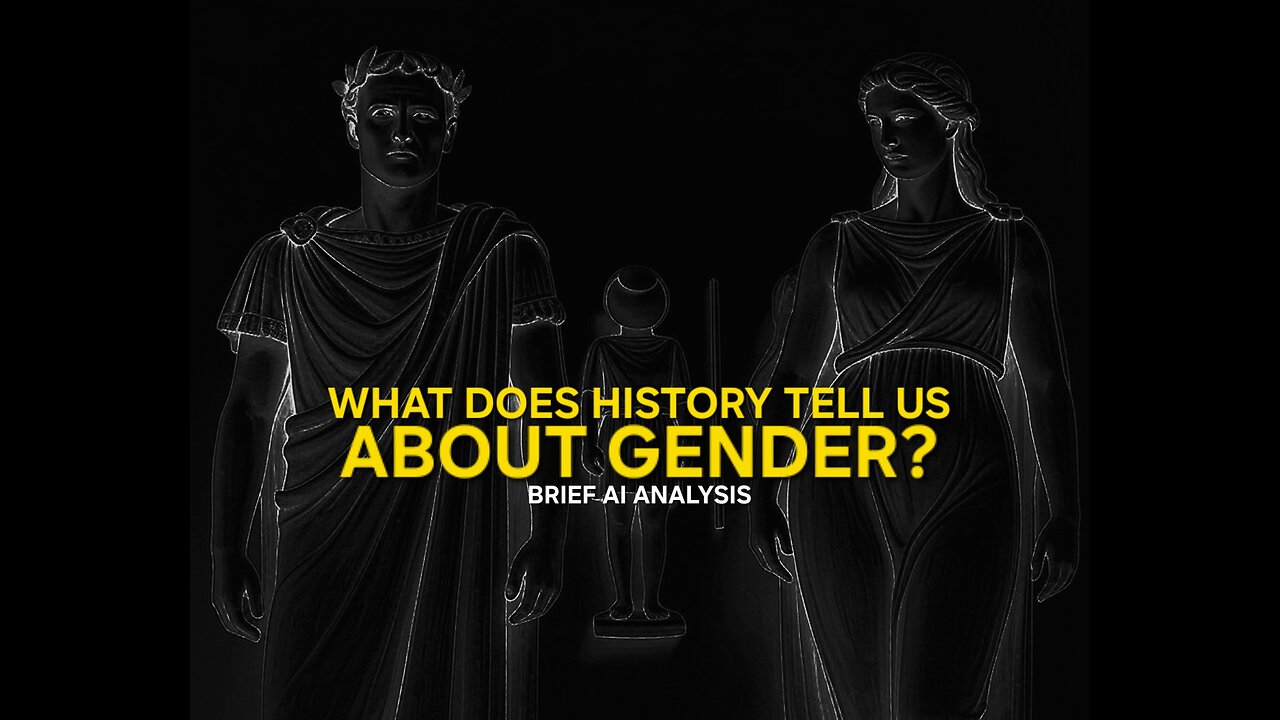Premium Only Content

What Does History Tell Us About Gender? #biology
Can history reveal where men were seen as women—or vice versa—shaping today’s third gender debates? The Echo Vector digs in, using AI tools like Grok and ChatGPT to uncover facts without bias. From ancient times to modern laws—watch and weigh in!
The next video will be a dive into tariffs, the history of tariffs, and much more on the possibilities at play. Subscribe for more, and share your thoughts below!
Disclaimer:
This video uses free stock video footage, which does not depict the people or places referenced.
All expressed opinions and ideas in this video are based on available data and AI analysis; they do not reflect official stances or endorsements.
#binary #ThirdGender #GenderIdentity #AIResearch #Biology #Clarity #TheEchoVector #transgender #history #facts
AI Sources:
• Beard, M. (1994). The Roman Triumph. Harvard University Press.
• Nanda, S. (1990). Neither Man Nor Woman: The Hijras of India. Wadsworth Publishing.
• Williams, W. L. (1986). The Spirit and the Flesh. Beacon Press.
• Stephen, L. (2002). Gender, Sexuality, and Meaning. University of Texas Press.
• Vasey, P. L., & Bartlett, N. H. (2007). “What Can the Samoan ‘Fa’afafine’ Teach Us?” Ethos.
• Young, A. (2000). Women Who Become Men. Berg Publishers.
• Looper, M. (2002). “Ancient Maya Gender Identity and Relations.” Gender in Pre-Hispanic America.
• American Psychiatric Association. (2013). Diagnostic and Statistical Manual of Mental Disorders (DSM-5).
• Bränström, R., & Pachankis, J. E. (2019). “Reduction in Mental Health Treatment Utilization…” American Journal of Psychiatry.
• Kaltenboeck, A., et al. (2021). “Correction to Bränström and Pachankis.” American Journal of Psychiatry.
• Centers for Medicare & Medicaid Services. (2023). “National Health Expenditure Data.”
• Williams Institute, UCLA. (2022). “How Many Adults and Youth Identify as Transgender…?”
• National Institute for Health and Care Excellence. (2021). “Evidence Review: Gonadotrophin Releasing Hormone Analogues…”
• Pew Research Center. (2021). “About One-in-Four U.S. Adults Know Someone Who Uses Gender-Neutral Pronouns.”
-
 10:54
10:54
Nate The Lawyer
2 days ago $8.68 earnedNEW Charges & Lawsuit For Fake Doctor Illegal Who Ran Schools For Decades
25.8K26 -
 LIVE
LIVE
Joker Effect
2 hours agoSTREAMER NEWS: Adin Ross, LupLupka, SideScrollers, N3on, TrainwrecksTv, Cuffem, WestCol, BottedWTF.
406 watching -
 DVR
DVR
IsaiahLCarter
1 day ago $3.35 earnedWill New York City Choose Communism? || APOSTATE RADIO 032 (with John D. Macari)
19.3K5 -
 2:31:41
2:31:41
Illyes Jr Gaming
5 hours agoRetro Sports Game Night NHL 94
4.57K3 -
 1:22:31
1:22:31
HELMETFIRE
2 hours ago🟢GAMING WITH FIRE EP14🟢
2.83K3 -
 1:46:04
1:46:04
Damysus Gaming
2 hours agoBorderlands 4 -UVH Grinding and Farming With Amon
2.18K2 -
 25:47
25:47
Robbi On The Record
5 hours ago $3.54 earnedExposing the OnlyFans Industry (Agency Edition)
12.6K4 -

ManoloCalifas
4 hours ago🔴 LIVE - BATTLEFIELD 6 ON A SUNDAY....
885 -
 9:06
9:06
MattMorseTV
7 hours ago $14.89 earnedSchumer just BETRAYED 32 million of his OWN VOTERS.
18.3K50 -
 4:41:36
4:41:36
BigTallRedneck
12 hours agoBRRRAP PACK FINALS TOURNAMENT EXCLUSIVELY ON RUMBLE
621